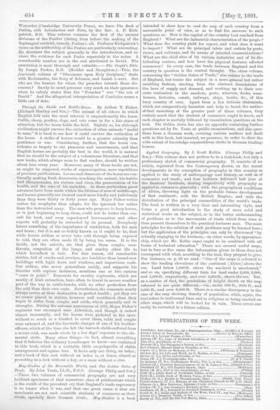Applied Geography. By J. Scott Keltie. (George Philip and Son.)—This
volume does not profess to bo a text?-book, but only a preliminary sketch of commercial geography. It consists of an article, reprinted from the Contemporary Review, on the recent developments in the conception of geography in this country as applied to the study of anthropology and history, as well as of economics and trade ; and four lectures delivered last year at the Bankers' Institute, dealing respectively with geography as applied to commerce generally ; with the geographical conditions of Africa, throwing light on the probable future development of that continent ; with the British Empire ; and with the distribution of the principal commodities of the world's trade. The book is written in a very clear and interesting style, and forms a good introduction to the study of more solid and statistical works on the subject, or to the better understanding of problems as to the movements of trade which from time to time present themselves to the practical business man. The main principles for the solution of such problems may be learned here ; but the application of the principles can only be discovered "by actually engaging in the business,—in other words, by apprentice- ship, which (as Mr. Keltie says) ought to be combined with all forms of technical education." There are several useful maps, but in four or five cases the information given in them does not correspond with what, according to the text, they purport to give. For instance, on p. 58 we read : "One of the maps is coloured to show the leading elevations of the continent [Africa] above the sea. Land below 1,000 ft. above the sea-level is uncoloured," and so on, specifying different tints for land under 2,000, 8,000, and 5,000 ft. respectively, and over 5,000 ft., above the sea. But, as a matter of fact, the gradations of height shown on the map referred to are quite different,—viz., under 600 ft., 3000 ft., and 6,000 ft., and over 6,000 ft. There is a similar discrepancy in the case of the map showing density of population, while, again, the text refers to isothermal lines and to religions as being marked on other maps, which will be looked for in vain. These errors can easily be corrected in a future edition.






































 Previous page
Previous page